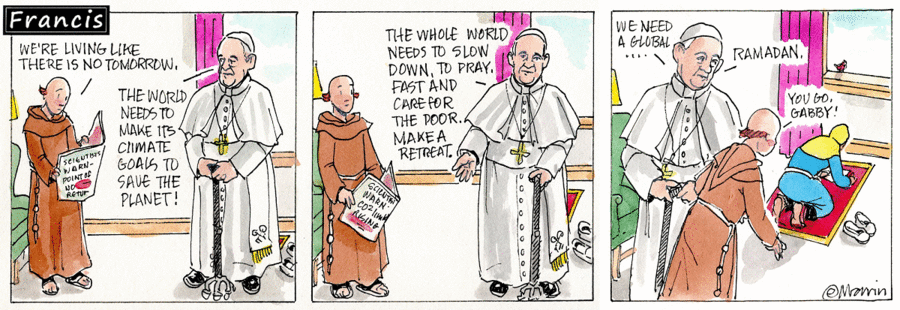CSotD: Non-Christian Charity
Skip to commentsFrancis (AMS) combines the dread news of the new report from the Intergovernmental Panel on Climate Change with the beginning of Ramadan to make a point about the sudden urge to Do Something as compared to having an ongoing tradition of Doing Something.
Ramadan began this week, but, of course, an observant Muslim like Gabby not only anticipates its coming but lives enough of a disciplined spiritual life throughout the year that it doesn’t come as a shock to the system.
Though I did have a Christian friend who scheduled a lovely vacation trip to Morocco only to discover, to her horror, that it coincided with Ramadan, so that, while she was strolling through the beauties of the land in 100+ degree temperatures, her guides were not simply fasting but were not permitted even a mouthful of water.
However, she reported, there was the compensation of iftar, a large, community meal, at the end of each day.
Iftar is a gift of charity, a spread to which the entire village is invited. Obviously, that’s going to vary depending on where you are and the resources available, but throughout the month-long observance, it’s a constant reminder of the need to be generous and charitable, not in the sense of a command but in the sense of a tradition.
Which brings us, oddly enough, to this Andertoons (AMS), in which the buffalo finds scant comfort in the fact that Indians find a use for every part of him. Which, yes, is a joke and I get it.
Then again, it’s also a myth, because, while the Indians had a use for every part of the buffalo, that doesn’t mean they put every part of every buffalo to every possible use.
Not only did they occasionally stampede a herd off a cliff, resulting in far more mass than they could possibly process, but there were times they’d be on the road and would kill a buffalo to feed the group, but would have neither the time nor the inclination to make thread out of sinews and so forth.
However, if you accept the spiritual setting involved, the buffalo would be willing to be sacrificed for the good of the community, and would be thanked for doing so.
Plus this: At least among the Lakota, it was considered dishonorable to pile up possessions. If you got enough buffalo robes to make a new cover for your tepee, you would give your old cover to someone in the village who did not have a hardy young hunter to provide for them.
And one of the ways in which Crazy Horse gained political power and stature was by being a highly successful horse raider. His skill and daring in this were admired, but, moreso, he was admired for regularly bringing home a string of horses and distributing the bulk of them among less fortunate people.
As with iftar, it was not something done in obedience to a command so much as something done as part of a tradition.
Traditions and commands can blend to become indistinguishable.
Francis Yeats-Brown, author of “Lives of a Bengal Lancer,” returned to India after World War I and reflected on the difference between life in the modern world and life in a world little changed by time.
There is a deep insincerity running through modern Christendom, because the average man and woman who goes to church no longer accepts the Church’s teachings on Heaven, Hell, the reality of the Devil, or the terror of the Wrath of God. We repeat the rich, rolling phrases of the prophets of Palestine, without giving them literal credence and hence we tend to similar hyperbole in our worldly affairs. A civilization that has lost its Faith, cannot keep faith in anything.
Mind you, I’ve known both Muslims and Indians who manage to be perfectly modern without being imperfectly modern. As Francis suggested, we could all use a global Ramadan.
Arctic Circle (KFS) brings up a doubly-relevant point, in part because I just did an on-line search to find the text of Lancer at Large so I could grab that quote, and in part because the Internet Archive is in court over its practice of lending scanned texts, which commercial publishers say deprives them of fair revenues.
I’m not sure why libraries can lend out physical books and the Archive wouldn’t be able to do it with virtual copies.
Pretty sure I’m missing a few details that will emerge in court.
I got a chuckle from this Karl Stevens cartoon because I’ve long since outgrown the notion that publishing popular dreck allows publishers to publish books that not many people are going to want to buy. I’m pretty sure what it allows them to do is to stuff money into their pockets.
As for the direct application to art museums, I recall a particular museum that once mounted major shows of Chagall, Dali, etc. and then ran a Snoopy show, which, as in Stevens’ cartoon, was supposed to underwrite more classical exhibits.
Which were then mounted in a broom closet on the third floor to make space for the popular stuff.
Though not all museums run on that basis: A few years back, I was at a conference in Chicago and found myself with a few hours before the train home, so I went over to the Art Institute to wander around.
The next time I’m in Chicago, I’m bringing a sleeping bag and setting up camp there for a week.
Juxtaposition of the Week
This is a Juxtaposition of the Week, not Day, because I had to search back for the Candorville from the 14th, which had originally triggered my response of “Raggedy Ann and Andy? Do they still make those?”
Which they do. And that’s comforting, because they don’t do anything. They’re just dolls, in a world in which toys are supposed to light up and play music and jump around and then fall apart, leaving little pieces of plastic scattered around the house.
My grandparents had the books, which I guess they had bought for my dad, who was born 102 years ago this coming Tuesday, or possibly his little sister, who wasn’t all that much younger.
I don’t want to see one of the dolls, however. I’d be afraid someone had improved them.








Comments 19
Comments are closed.